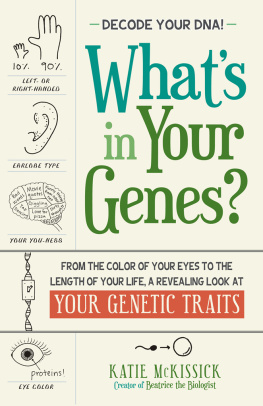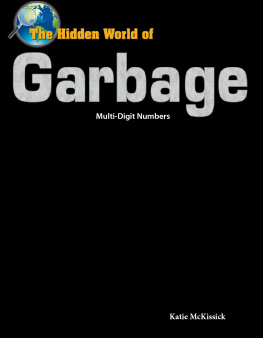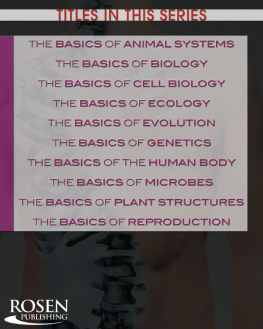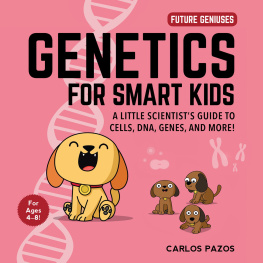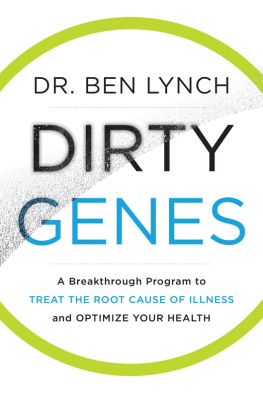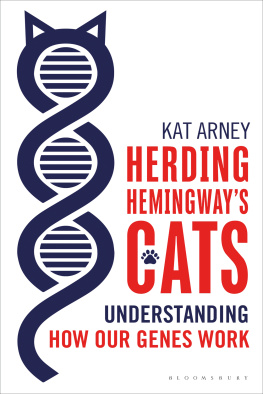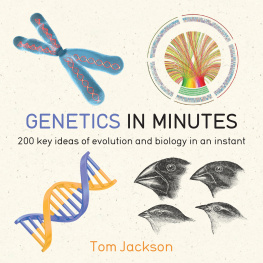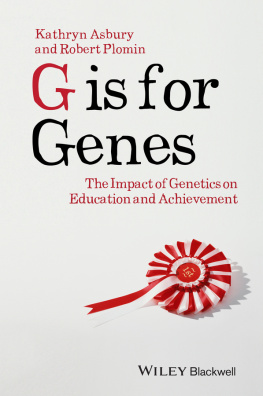Whats in Your Genes?
FROM THE COLOR OF YOUR EYES
TO THE LENGTH OF YOUR LIFE,
A REVEALING LOOK AT
YOUR GENETIC TRAITS
KATIE McKISSICK
Creator of Beatrice the Biologist

Avon, Massachusetts
Dedication
For my grandfather, Dr. Michael Lyons to some, who to me was and will always be Papa.
For always encouraging me and pointing me in the direction of science.
For indulging my curiosities, taking me to the medical school to play with high-powered microscopes and see parts of cadavers thawing in the sink.
For suggesting that I be a science writer before I could fathom that I would ever even be capable of such a thing.
When I visited him in the hospital, I typed at his bedside while he slept. Im glad I was able to tell him that my science writing dreams were coming true. When he woke up from a nap, I told him I was working on a book about genetics. He said to me, I cant wait to read it.
I love you, Papa. Rest in peace.
Introduction
Most of us would like to think we are special and amazing because of our essential, mysterious self-i-ness, but its really because of our DNA. Experiences of course matter too, but much of who we are and who we become is written inside of us. While its romantic to think that our identities cant be quantified, I think its more poetic that we have it inscribed in every part of our bodies instead.
But dont fretyou still have that wonderful you-ness that no one else has, for no one else has your DNA sequence (at least, statistically speaking Im pretty comfortable saying that, provided that you dont have an identical twin), and certainly no one has your unique past of influential experiences.
The beauty of peering inside our DNA is that it contains all the stories of our past, linking us to our deepest of rootsour parents, grandparents, great-grandparents, all the way back to our ancient ancestors, some of whom were human, others who were not. Its a book thats been revised, rewritten, and edited over the course of more than three billion years. Through it, we are connected to every other living thing on the entire planet that is alive today or has ever lived. This is serious stuff, man.
Teasing the secrets from our DNA is a work in progress, so you need not worry that someone can steal a piece of hair or some chewed gum of yours and with scientific finagling see into your soul. What we know and dont know about genetics is constantly changing. Many of the things that I say here are still under investigation, and the details will be ironed out in just the next few yearsits all moving that fast. Some of the details that scientists are relatively certain of today could be proven wrong tomorrow. Its a pretty tumultuous area, genetics. But what wont ever be out of date are my musings about its importance and its intrigue. Im always in style (at least I hope so).
Genetics has so many terms its more like speaking another language than just learning about heredity. Science is known for its jargon, certainly, but genetics is particularly vocabulary heavy. Thats why theres a glossary at the end of this book for easy reference. Despite the plethora of terms, I will at all costs avoid turning this book into a steaming pile of vocabulary lessons. I will use the authentic science terms when I feel its valuable, but Ill gloss over them or use synonyms when I feel that its not. This may anger some of my scientist brethren, but to them I say, Pffft. Whatevah.
In the pages that follow, I will draw rudimentary cave paintings of chromosomes for you, make dirty jokes about proteins, and make fun of just about every historical scientist possible.
If you are looking for a serious take on the science of heredity, you wont find your fix within these pages. There are plenty of textbooks out there for that (they are also effective doorstops). What I want to do is cover all the bases of genetics while entertaining you. Ill distill the most cutting-edge research (which surely will be outdated in just a few years) and historical context into a conversation that I would gladly have over coffee with anyone willing to listen, and will have with you via the following pages.
Science is serious business, to be sure, but it doesnt always need to be taken so damn seriously. While it may be our species greatest achievement, responsible for every technological advance we have or ever will make, science is also poop and sex and boogers. So lets put our feet up and discuss DNA drama, gardening-crazed monks, and superpowers. Because that is what genetics is really all about.
PART 1
The Basics
Your Friend, DNA
DNA isnt much of a showboat. It stays hidden away inside your cells, preferring to be left alone, keeping all its secrets. (Sounds a lot like my ideal vacation.) But sorry, DNA. Were going to be intruding on that personal space of yours, whether you like it or not.
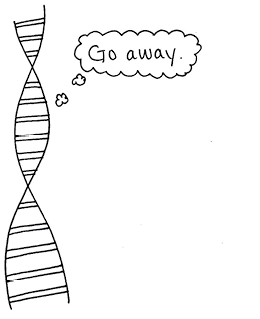
DNA is a useful acronym, because the full name is a bit of a mouthful: deoxyribonucleic acid. Yeah, I know. Its not a great name, but dont blame me. I wasnt around when it was named. I would have saved everyone a lot of time by naming it Reginald, or maybe Gladys. But this is the name were stuck with. I know it looks daunting, but when you split it apart, its not so bad.
DNA: An acronym for deoxyribonucleic acid, which is really boring stuff that is found in all of your cells and contains all the information for making you who you are. You know. No big deal.
Deoxy is just there to say that something has one less oxygen atom. What exactly has one less oxygen? The next part of the name, ribo. Thats short for a sugar called ribose. So the whole first part, de-oxy-ribo just means that there is something in it called a ribose thats missing one oxygen atom. So far, so good.
Deoxyribose: A pentagon-shaped sugar that is found in the backbone of DNA.
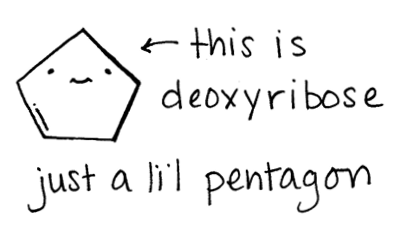
Now lets get to that ribose bit I mentioned. Ribose and deoxyribose are sugars. -ose is actually a very popular ending for various types of sugars. (Think of glucose, sucrose, and fructose.) Deoxyribose isnt nearly as popular as these other sugars, but it should be, since its an important part of DNA. Deoxyribose is part of the backbone of DNAthe sides of the twisted ladder.
The other part of the backbone is something called a phosphate group. Its made of an atom of phosphorous and four atoms of oxygen. The sides of the DNA ladder are alternating phosphate groups and deoxyriboses. My word processor doesnt think that deoxyribose is a real word, but Ill have to assure it that it is.
Phosphate: A chemical compound that makes up part of the backbone of DNA. It is a phosphorous atom surrounded by four oxygen atoms.
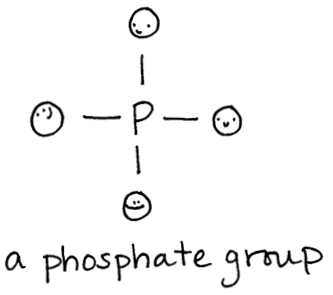
But the backbone of sugar and phosphates is not exactly the fun part of DNA. The real business-doing portion of DNA is in the rungs of the ladder where the bases live. You may have heard of the bases of DNA beforetheyre those letters A, T, C, and G. Their full names are adenine, thymine, cytosine, and guanine. Its pairs of these guys that make the rungs of that DNA ladder. The bases are very particular about how they go about this: A pairs with T, C pairs with G. I heard that A cant stand to be around C, and G thinks T is an obnoxious brat. But you didnt hear that from me.

